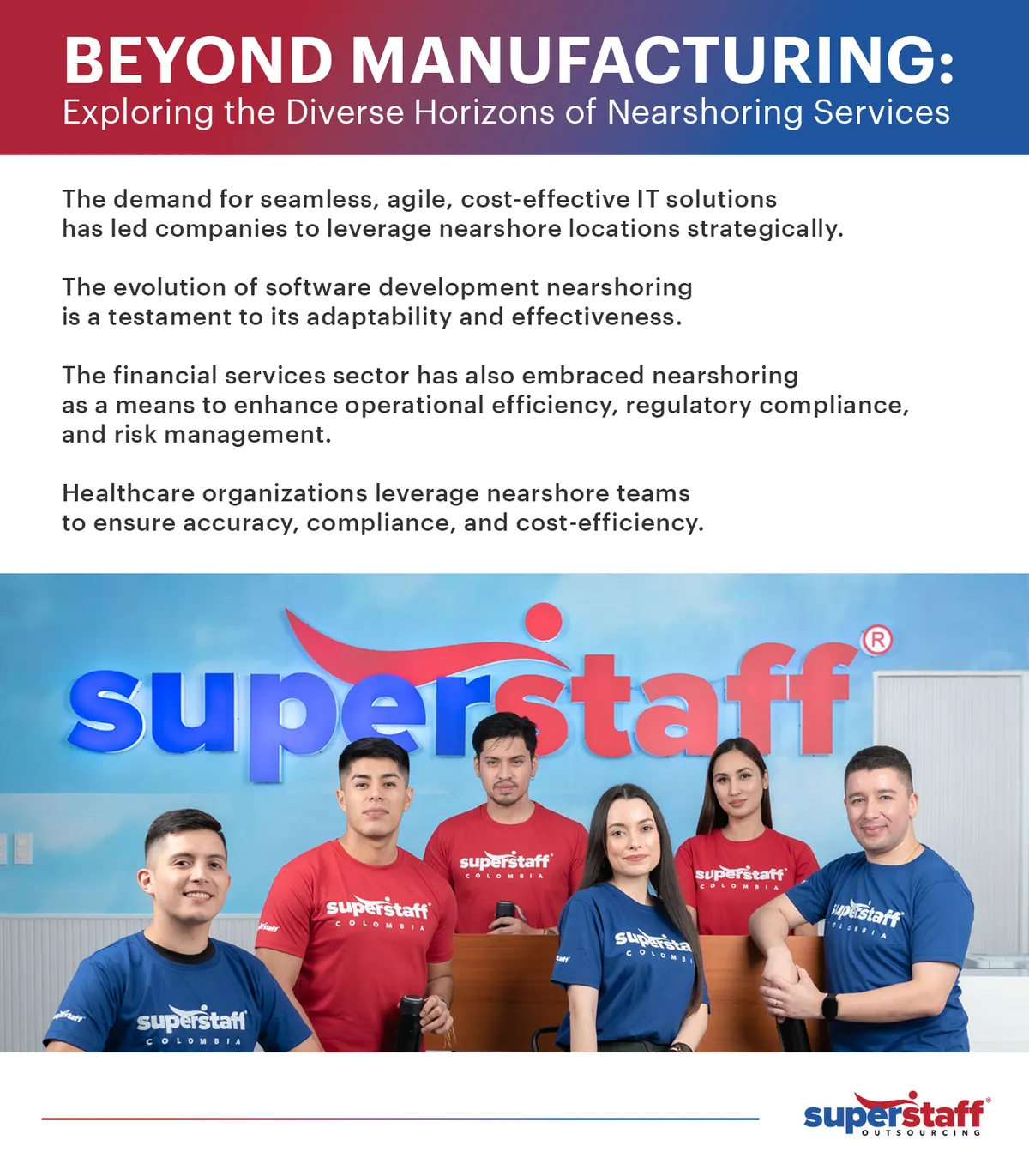
Mexico’s Economy Minister Raquel Buenrostro revealed that in 2022 alone, 400 North American companies explored the possibility of nearshoring their operations from Asia to Mexico. The resounding sentiment among decision-makers was clear: the era of relying solely on distant Asian markets has ended. However, the rise of nearshoring is not merely a response to past challenges but a strategic solution to build resilient and efficient supply chains for the future.
Nearshoring to Latin America offers several advantages for businesses, including reduced lead times, enhanced agility, and lower transportation costs. With proximity to the market, the LatAm call center industry ensures quicker response times to changing consumer demands, providing a competitive edge in an ever-evolving business industry.
Why are Businesses Moving Operations to Latin America
The China-US trade, geopolitical tensions, and trade uncertainties primarily fuel the shifting dynamics. This combination of factors has prompted companies to reevaluate their supply chain strategies, seeking locations that offer proximity to key markets while minimizing geopolitical risks. With its strategic location and trade agreements, Latin America has emerged as a prime candidate for nearshoring initiatives.
Industry Behemoths That Are Moving Operations to Latin America
Apple’s Strategic Moves
Apple’s decision to move manufacturing away from China is influenced by various factors, including the China-US trade war, uncertainties surrounding COVID-19 lockdowns, and political considerations. The tech giant is strategically diversifying its production centers across Latin American countries, India, Vietnam, and the U.S. This move not only mitigates risks associated with China but also aligns with Apple’s image, providing political advantages, especially in the context of President Biden’s initiatives to bolster semiconductor production in the US.
General Motors’ Latin American Expansion
After losing ground in China, General Motors is actively diversifying its market presence by kickstarting production in Argentina. With plans to export vehicles to other Latin American countries, this move showcases the region’s potential as a hub for automotive manufacturing and distribution. The automobile giant’s strategic decision reflects a proactive approach to geopolitical and economic challenges, ensuring sustainability and growth.
Dell’s Supply Chain Diversification
In response to Washington-Beijing tensions, Dell is steering away from “made in China” components and aims to phase out Chinese-made chips by 2024. This diversification effort aligns with broader supply chain resilience strategies, reflecting the company’s commitment to mitigating risks associated with geopolitical uncertainties.
The strategic moves of industry titans like Apple, General Motors, and Dell signal a significant shift in operations towards LatAm, underscoring the region’s growing prominence in global business strategies. These shifts highlight Latin America’s allure, presenting a viable solution for industry leaders seeking resilience, market diversification, and reduced geopolitical risks in their global operations.
Nearshoring Is Not Limited to Manufacturing and Production
Nearshoring has evolved beyond its origins as a mere cost-cutting measure. What was once primarily associated with geographic proximity for streamlined manufacturing has become a comprehensive strategy embraced across virtually all sectors. Today, a nearshoring outsourcing company is a powerful tool for efficiency, innovation, and overall competitiveness.
From IT services and software development to finance and healthcare, nearshoring has transcended its initial role as a cost optimization tool. Instead, it has become a comprehensive strategy that empowers businesses to achieve operational excellence, access a specialized talent pool, and stay competitive in a rapidly changing global landscape.
- IT Services
Nearshoring is now a cornerstone in the realm of IT services. The demand for seamless, agile, cost-effective solutions has led companies to leverage nearshore locations strategically. This approach offers several advantages, including reduced latency, improved communication, and a skilled workforce.
For businesses seeking multilingual tech support, nearshoring has proven to be a game-changer. Strategic hiring of customer support teams in key markets fosters linguistic fluency, cultural understanding, and enhanced customer satisfaction.
- Software Development
The evolution of software development nearshoring is a testament to its adaptability and effectiveness. As the demand for cutting-edge software solutions continues, companies turn to nearshore outsourcing to access top-tier talent pools.
Nearshore software development facilitates collaboration across time zones, accelerates development, and ensures high-quality, innovative solutions. It is a strategic approach for companies aiming to stay ahead in the dynamic and competitive tech landscape.
- Finance
The financial services sector has also embraced nearshoring to enhance operational efficiency, regulatory compliance, and risk management. Nearshore locations allow financial institutions to adapt to changing market conditions while maintaining cost-effectiveness. Moreover, the proximity to key financial markets ensures timely and compliant service delivery. Strategic nearshoring in finance exemplifies its role as a catalyst for growth and adaptability in a sector that demands precision and responsiveness.
- Healthcare
From medical coding and billing to back-office support functions, healthcare organizations leverage nearshore teams to ensure accuracy, compliance, and cost-efficiency. Healthcare support services in nearshore locations allow seamless collaboration with onshore teams, facilitating improved patient outcomes and operational excellence.
Nearshoring Tech Roles
One notable sector where nearshoring has found widespread acceptance is Information Technology (IT) services. Companies increasingly recognize the advantages of locating IT support and development teams in nearshore locations.
Access to a skilled workforce, cultural alignment, and reduced time zone differences facilitate seamless collaboration and efficient project management. Meanwhile, proximity ensures faster response times and greater agility in addressing IT-related issues, all while maintaining cost efficiency.
Software Development
Software development is a pivotal domain where this outsourcing model is particularly beneficial.
This is why the nearshore software development model is gaining prominence, especially among businesses that seek high-quality results from nearshore developers based in countries with minimal time zone differences. Leading global companies such as Google, Tesla, Porsche, Johnson & Johnson, EY, IBM, and many others are setting the trend by nearshore outsourcing software development for their tech needs. These industry giants showcase the effectiveness of leveraging a nearshore software development company.
IT Support and Maintenance
In outsourcing, the geographical position of nearshore IT support teams is a factor that cannot be overlooked. The proximity of your in-house team to your outsourced team is a strategic advantage. This closeness facilitates seamless communication and frequent in-person meetings, thanks to easy travel distances and lower costs.
The ability to collaborate in real-time, share information seamlessly, and meet regularly in person accelerates project timelines and enhances overall efficiency. Colombia call center services’ positive impact is reflected in the performance of individual projects and the overarching success.
Data Science and Analytics
Due to lower labor costs, one of the primary advantages of nearshore data science and analytics roles is significant cost savings. Nevertheless, the benefits of nearshoring extend beyond financial considerations. Nearshoring companies provide access to top talent in STEM fields, particularly in data science and analytics. This strategic alignment ensures that businesses save costs and tap into specialized expertise, enhancing the overall quality of their data-driven projects.
As businesses increasingly recognize the value of data-driven decision-making, the nearshore outsourcing model stands out as a transformative solution, ensuring financial savings and the expertise required to unlock actionable insights.
Project Management
Strategic nearshoring of project management roles plays a pivotal role in ensuring the success of technology-related projects. These roles encompass Project Managers, Scrum Masters, and Agile Coaches — professionals who bring specialized expertise to streamline project execution and maximize efficiency.
UX/UI Design
UX and UI designers are vital in crafting digital experiences beyond aesthetics. The focus is on creating interfaces that are not only visually appealing but also intuitive and user-friendly.
The nearshore model fosters a collaborative design process where UX and UI designers work closely with onshore stakeholders. This collaboration ensures that design iterations are efficient, feedback is incorporated seamlessly, and the final product reflects a harmonious blend of creativity and functionality. The geographic proximity of nearshore teams contributes to a dynamic and iterative design process.
Nearshoring is Not Limited to Mexico
It’s crucial to understand that the concept of nearshoring extends far beyond the borders of Mexico. While Mexico has been a prominent nearshore destination that offers strategic advantages for various industries, businesses need to recognize the diverse range of nearshore opportunities available across different regions.
As a strategic approach, nearshoring involves seeking business partners and operational centers in geographically close locations. The goal is to optimize collaboration, reduce logistical challenges, and tap into specialized talent pools. Given this, businesses should explore other nearshore possibilities, such as Colombia, the “Silicon Valley of Latin America,” to align their operations with specific needs and goals.
Considering alternative nearshore destinations allows you to diversify your strategies while considering language proficiency, cultural alignment, and regulatory environments. Ultimately, exploring more diverse destinations across Latin America and the Caribbean allows you to tailor your initiatives based on industry requirements and preferences.
Why Doing Business in Colombia Through Nearshoring Is a Strategic Move for Global Enterprises
Nearshoring has emerged as a strategic avenue for companies aiming to optimize their operations. Amid this trend, Colombia has become a prominent hub for businesses seeking to expand their footprint, diversify supply chains, and capitalize on emerging market opportunities. Let’s delve into the benefits of nearshoring in Colombia and explore why it’s becoming an increasingly favored approach for enterprises worldwide.
Proximity
One of the immediate advantages of proximity in nearshoring is the reduction in transportation times and costs. Let’s consider the example of a flight from Medellin (MDE) to New York (NYC), which takes approximately 5 hours and 36 minutes. This proximity enables quicker responses to market demands and faster delivery times. Whether adapting to changing consumer preferences or seizing unforeseen business opportunities, the ability to act swiftly is a competitive advantage that proximity brings.
In an era where customer experience is paramount, proximity enhances customer satisfaction. Faster delivery times and responsive services contribute to an overall positive customer experience. Nearshoring ensures companies meet and exceed customer expectations, fostering brand loyalty and long-term partnerships.
Time Zone Synchronicity
Similar time zones enable nearshore teams to work in tandem with their U.S. counterparts for real-time updates. This synchronized workflow ensures that the nearshore partner can collaborate seamlessly with colleagues, fostering a dynamic exchange of ideas and information.
The absence of a time difference between Colombia and Washington, DC, USA, is a tangible example of the synchronicity that can be achieved through strategic nearshoring initiatives.
With a shared workday, decision-makers from headquarters and the nearshore team can engage in collaborative discussions without delays. This proactive approach ensures that any problems are addressed promptly, preventing potential setbacks and maintaining the momentum of project timelines.
Linguistic and Cultural Compatibility
Establishing a working relationship becomes inherently easier when nearby countries share cultural similarities. This compatibility extends beyond breaking language barriers; it encompasses a deep understanding of cultural nuances, communication styles, and business etiquette.
Cultural and linguistic compatibility is necessary for fostering effective communication within nearshore teams. The shared cultural context enables teams to communicate more intuitively, reducing the risk of misinterpretations. A common language and cultural understanding become conduits for open and transparent communication, essential elements in the success of any collaborative effort.
Given the country’s deep diplomatic, historical, and business ties with the U.S., the cultural similarities offered by Colombian outsourcing companies create an environment conducive to building strong working relationships. This connection transcends professional interactions, contributing to a positive and collaborative work environment.
Reduced Risk
Nearshoring acts as a shield against the impact of geopolitical tensions, providing companies with a strategic advantage in uncertain global scenarios. Strategically nearshoring to BPO centers in Colombia allows companies to minimize geopolitical risks that could otherwise disrupt supply chains and impact operational continuity.
The strategic concentration of production in a nearby country such as Colombia contributes to more streamlined inventory management and shorter lead times. Proximity in nearshoring allows companies to exert better control over their supply chains, facilitating agile responses to changing market demands. This streamlined approach enhances overall operational efficiency and responsiveness. It also allows companies to adapt to market dynamics, reduce lead times, and maintain operational resilience.
Trade Agreements and Incentives
The ongoing trade war with China has prompted reshoring in the United States and fueled nearshoring to Latin America.
For instance, the positive effects of a robust trade agreement are exemplified in the relationship between the United States and Mexico. As highlighted in a recent Kearney report, during the trade war with China in 2019, China’s exports to the United States saw a decline of $90 billion. In contrast, Mexico experienced an increase of $13 billion. This phenomenon extends to other Latin American countries that offer outsourcing solutions, like Colombia.
The nearshoring multiplier effect comes into play when other Latin American countries observe the success of U.S.-Latin America trade agreements fueled by strategic nearshoring. As the benefits become apparent, more nations are likely to adopt similar models, creating diversified opportunities for businesses seeking to optimize their operations through nearshoring initiatives.
Unlock Your Potential: Nearshoring to Latin America for a Strategic Edge
With a proven track record in delivering top-tier talent, streamlined processes, and cost-effective solutions, SuperStaff offers a gateway to harnessing Latin America’s rich pool of skilled professionals. By partnering with SuperStaff, you gain access to a dedicated team proficient in diverse tech roles, ensuring seamless collaboration, cultural alignment, and accelerated innovation. Embrace efficiency, reliability, and agility in your tech endeavors.
Choose a nearshore company that can guarantee your success. Choose SuperStaff!








